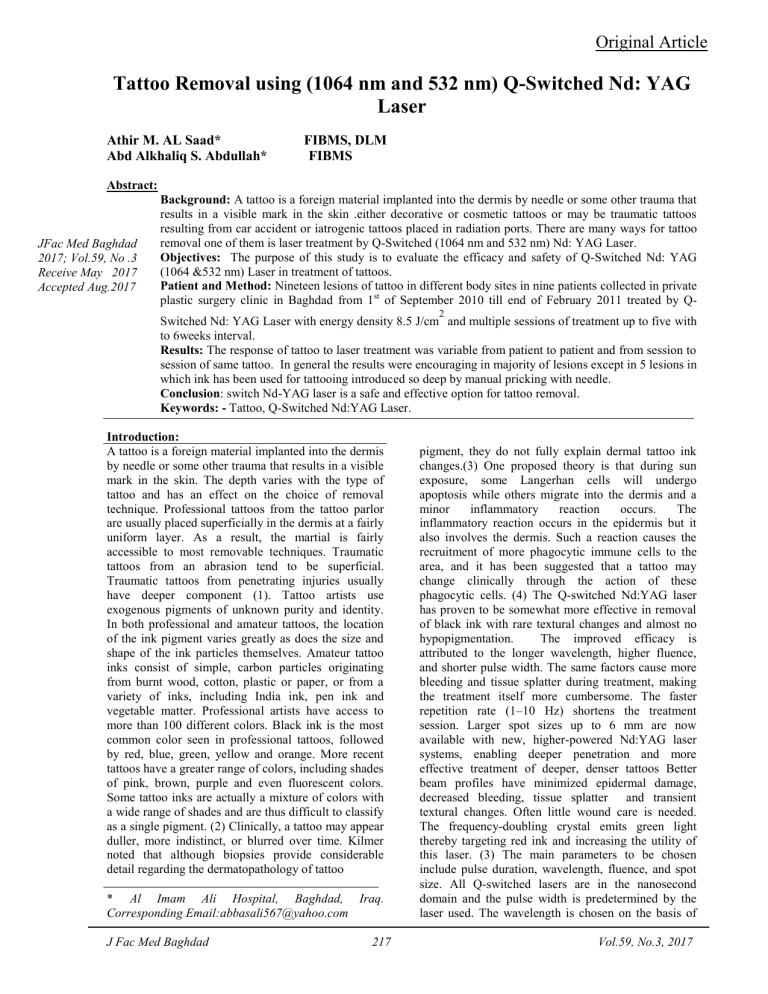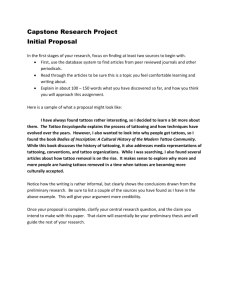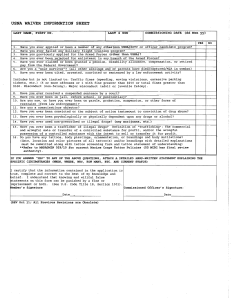
Tattoo Removal using (1064 nm and 532 nm) Q-Switched Nd:YAG Laser Original Article Athir M. AL Saad Tattoo Removal using (1064 nm and 532 nm) Q-Switched Nd: YAG Laser Athir M. AL Saad* Abd Alkhaliq S. Abdullah* FIBMS, DLM FIBMS Abstract: JFac Med Baghdad 2017; Vol.59, No .3 Receive May 2017 Accepted Aug.2017 Background: A tattoo is a foreign material implanted into the dermis by needle or some other trauma that results in a visible mark in the skin .either decorative or cosmetic tattoos or may be traumatic tattoos resulting from car accident or iatrogenic tattoos placed in radiation ports. There are many ways for tattoo removal one of them is laser treatment by Q-Switched (1064 nm and 532 nm) Nd: YAG Laser. Objectives: The purpose of this study is to evaluate the efficacy and safety of Q-Switched Nd: YAG (1064 &532 nm) Laser in treatment of tattoos. Patient and Method: Nineteen lesions of tattoo in different body sites in nine patients collected in private plastic surgery clinic in Baghdad from 1st of September 2010 till end of February 2011 treated by Q2 Switched Nd: YAG Laser with energy density 8.5 J/cm and multiple sessions of treatment up to five with to 6weeks interval. Results: The response of tattoo to laser treatment was variable from patient to patient and from session to session of same tattoo. In general the results were encouraging in majority of lesions except in 5 lesions in which ink has been used for tattooing introduced so deep by manual pricking with needle. Conclusion: switch Nd-YAG laser is a safe and effective option for tattoo removal. Keywords: - Tattoo, Q-Switched Nd:YAG Laser. Introduction: A tattoo is a foreign material implanted into the dermis by needle or some other trauma that results in a visible mark in the skin. The depth varies with the type of tattoo and has an effect on the choice of removal technique. Professional tattoos from the tattoo parlor are usually placed superficially in the dermis at a fairly uniform layer. As a result, the martial is fairly accessible to most removable techniques. Traumatic tattoos from an abrasion tend to be superficial. Traumatic tattoos from penetrating injuries usually have deeper component (1). Tattoo artists use exogenous pigments of unknown purity and identity. In both professional and amateur tattoos, the location of the ink pigment varies greatly as does the size and shape of the ink particles themselves. Amateur tattoo inks consist of simple, carbon particles originating from burnt wood, cotton, plastic or paper, or from a variety of inks, including India ink, pen ink and vegetable matter. Professional artists have access to more than 100 different colors. Black ink is the most common color seen in professional tattoos, followed by red, blue, green, yellow and orange. More recent tattoos have a greater range of colors, including shades of pink, brown, purple and even fluorescent colors. Some tattoo inks are actually a mixture of colors with a wide range of shades and are thus difficult to classify as a single pigment. (2) Clinically, a tattoo may appear duller, more indistinct, or blurred over time. Kilmer noted that although biopsies provide considerable detail regarding the dermatopathology of tattoo * Al Imam Ali Hospital, Baghdad, Iraq. Corresponding Email:abbasali567@yahoo.com J Fac Med Baghdad 217 pigment, they do not fully explain dermal tattoo ink changes.(3) One proposed theory is that during sun exposure, some Langerhan cells will undergo apoptosis while others migrate into the dermis and a minor inflammatory reaction occurs. The inflammatory reaction occurs in the epidermis but it also involves the dermis. Such a reaction causes the recruitment of more phagocytic immune cells to the area, and it has been suggested that a tattoo may change clinically through the action of these phagocytic cells. (4) The Q-switched Nd:YAG laser has proven to be somewhat more effective in removal of black ink with rare textural changes and almost no hypopigmentation. The improved efficacy is attributed to the longer wavelength, higher fluence, and shorter pulse width. The same factors cause more bleeding and tissue splatter during treatment, making the treatment itself more cumbersome. The faster repetition rate (1–10 Hz) shortens the treatment session. Larger spot sizes up to 6 mm are now available with new, higher-powered Nd:YAG laser systems, enabling deeper penetration and more effective treatment of deeper, denser tattoos Better beam profiles have minimized epidermal damage, decreased bleeding, tissue splatter and transient textural changes. Often little wound care is needed. The frequency-doubling crystal emits green light thereby targeting red ink and increasing the utility of this laser. (3) The main parameters to be chosen include pulse duration, wavelength, fluence, and spot size. All Q-switched lasers are in the nanosecond domain and the pulse width is predetermined by the laser used. The wavelength is chosen on the basis of Vol.59, No.3, 2017 Tattoo Removal using (1064 nm and 532 nm) Q-Switched Nd:YAG Laser the best available wavelength for the tattoo ink color to be treated. In other words, red ink is best treated by a green wavelength (510 or 532 nm) and green ink is best treated by a red wavelength (694 or 755 nm). When melanin is present, the 1064 nm wavelength is the best choice to avoid disrupting the epidermis. (3) In contrast to lasers modalities, the Q-switched lasers are much more effective with very few side effects which are: pigmenting and textural changes, allergic reactions, ink darkening, epidermal debris. (5, 6) Patients and Methods: Nine male patients aged 20-43 mean 36 years old, with skin type 3& 4 having 19 tattoos in different sites in the body with different colors and different durations from few months till 20 years (mean 8 years).These patients collected in private plastic surgery clinic in Baghdad from 1st of September 2010 till end of February 2011. History has been taken from each patient and for each tattoo area includes: Age of patient, duration of each tattoo lesion, motivation of removal, mechanism of administration of tattoo (machine or manual pricking by needle),type of dye be used (ink or carbonized particles),previous medications, drug history, systemic illnesses, expectation of results. Physical examination: general and local examination includes: Site, dimensions, skin color type & texture and associated lesions as scar. The laser employed in the present work is a Qswitched Nd:YAG laser which is a solid state laser . Specifications: Wavelength 1064nm and 532nm, Class ӏӏӏb. Maximum output energy 1000mJ for 1064nm and 500mJ for 532nm. Pulse duration 610nsec Spot size 2-3mm. Frequency 1-6 Hz. Photographs has been taken by a digital camera for documentation, an antiseptic solution(10% povidon iodine) used, Switching on the laser device then energy setting and frequency setting. The parameter that used: - Wavelength 1064nm for blue and black tattoos and 532nm for red tattoos. Spot size 3mm. Frequency 3 Hz. Energy 600mJ for 1064nm and 300mJ for 532nm. Position of patient supine or sitting position accordingly. Safety measure: opaque eyewear for patient and goggles for operator. Laser beam application in perpendicular way and determined distance between hand piece and skin surface with one pass and minimal overlap in a speed 9mm per second. Post-operative measures include: Application of icy gel to laser treated area for few minutes, local antibiotics (fucidin ointment) three times per day for one to two weeks, systemic antibiotic used in one patient (ciprofloxcilin tab. 500mg two times daily) with history of diabetes mellitus, simple analgesia as Acetaminophen tablets in five patients, advice the patients (washing in a second day, no scraping of scab but let it separate spontaneously to minimize the scar). Follow up 1st week check the blister formation, ooze and edema. 2nd week fading and scaling. J Fac Med Baghdad 218 Athir M. AL Saad 3rd week follow skin texture changes, pigmentery changes and decision of other session date. The time interval between each session was three to six weeks and the number of sessions varies from one to five sessions. Results: All patients suffer from tolerable pain and discomfort during the procedure. Immediate whitening, associated with punctuates redness; of treated area continue about 20- 30 minutes (fig 1). Swelling of treated and adjacent area lasts for two to three days. Crustation and scaling then complete healing within two weeks. All patients suffer from transient hyper pigmentations that resolved after few weeks. The degree of fading of tattoo is varies between lesion to lesion and from session to session of the same case: Five (26.32%) tattoos that done by manual pricking with ink have no response to two sessions of laser treatment which was done three weeks apart. Three (15.78%) tattoos that done by machine with ink (professional) respond well by laser. Eleven (57.90%) tattoos that done by manual pricking with carbonized particles (amateur) respond better by laser. All laser treated areas have no change of skin texture or scar formation. Green part of colored tattoo did not respond to 1064nm or 532nm Nd-YAG laser. One patient with history of diabetes mellitus and tattoo, we found that there is noticeable difference in response to laser treatment when compare with other patients in which there is less response to treatment. The response of tattoo with scar association treated by laser was the same as that of tattoo without scar association. Table 1:- Site and number of tattoos Site Left arm Right arm Left forearm Left hand Right forearm Back Total No. of tattoos 6 2 3 4 2 2 19 Percentage (%) 31.58 10.53 15.78 21.05 10.53 10.53 100 Table 2:- Tattoo number versus mechanism of administration and type Tattoo No. 3 5 11 Mechanism Machine with ink Manual pricking by needle With ink Manual pricking by needle With carbonized particles Percentage (%) 15.78 26.32 57.90 Table 3:- Tattoo color and percentage tattoo 11 4 4 color Light blue Dark blue Colored (red ,blue ,green, black) Percentage (%) 57.90 21.05 21.05 Table 4:- Tattoo and scar association Tattoo 4 15 Scar association Yes No Percentage (%) 21.05 78.95 Vol.59, No.3, 2017 Tattoo Removal using (1064 nm and 532 nm) Q-Switched Nd:YAG Laser a b c Figure 1:- amateur light blue tattoo in left forearm treated by Q-switched Nd: YAG 1064nm. Laser, three sessions of treatment, 4 to 5 weeks interval a: before treatment b: immediately after first session note the whitening with redness and swelling c: five weeks after third session 8 Table 5: tattoo types, sites, colors and number of laser sessions and response Lesion N0. Site Color 1 L. forearm R. arm Light blue Blue, red, green Light blue Light blue Light blue Light blue Red, black Light blue Light blue dark blue 2 3 4 L. forearm L. arm 5 L. hand 6 L. hand 7 10 L. forearm R. forearm R. forearm L. hand 11 L. hand 8 9 Light J Fac Med Baghdad Type and method of tattoo amateur Treatment session(s) % of fading 3 90 professional 2 20 amateur 1 10 amateur 3 80 amateur 2 100 amateur 2 100 professional 5 100 amateur 2 100 amateur 3 60 Ink and manual pricking amateur 2 0 3 75 219 Athir M. AL Saad blue Red, blue blue, red 12 L. arm 13 back 14 back dark blue 15 L. arm 16 L. arm Light blue dark blue 17 L. arm 18 L. arm 19 R. arm Light blue Light blue dark blue professional 2 20 Ink and manual pricking Ink and manual pricking amateur 2 0 2 0 4 90 Ink and manual prinking amateur 2 0 4 60 amateur 4 60 Ink and manual prinking 2 0 Discussion: Complete laser tattoo removal requires multiple treatment sessions, typically spaced at least 6 weeks apart. At each session, some but not all of the tattoo pigment particles are effectively fragmented, and the body removes the smallest fragments over the course of several weeks. The result is that the tattoo is lightened over time. Remaining large particles of tattoo pigment are then targeted at subsequent treatment sessions, causing further lightening. (7) Immediately after laser treatment, a slightly elevated, white discoloration with or without the presence of punctuate redness is often observed. This white color change is thought to be the result of rapid, heat-formed steam or gas, causing dermal and epidermal vacuolization. Pinpoint bleeding represents vascular injury from photo acoustic waves created by the laser's interaction with tattoo pigment. (8) No use of local anesthesia may improve the results because reports have noted that patients receiving anesthesia by local injection will require additional treatments as the injection causes mechanical edema, spreading out the tattoo ink, which in turn makes it more difficult for the laser light to act on specific ink particles. It has been reported that infiltration of local anesthesia will add an additional treatment or two. (8)Topical anesthesia not affects laser absorption, so we can use topical cream like EMLA thirty minute before the procedure, we did not use topical anesthesia in our study because our patients tolerated well to procedure. The energy that selected is 600-800mj because at this range this energy is enough to cause immediate whitening without punctuate bleeding or immediate blistering to target tattoo lesions at 3 mm spot size. (3) And this explains no scar formation. i.e. in higher energy density may cause skin damage and subsequently scaring. The results is well in tattoos that done by machine with ink (professional tattoo) as compare with that tattoos were done by manual pricking by needle with ink this is because the presence of tattoo pigments is more superficial and uniformly distributed in a case of tattoo Vol.59, No.3, 2017 Tattoo Removal using (1064 nm and 532 nm) Q-Switched Nd:YAG Laser done by machine, this proved by checking random sample with professional tattoo in which all tattoo pigments are removed by skin graft knife this knife capable to remove the epidermis and part of dermis. The amateur tattoo ink is eliminated faster than professional ink, this is in agree with Fatima A. Mohammad Ali and Ali S. Mahmood study (9) this is most likely due that the carbonized particles are easier to be fragmented by laser and phagocytized by macrophages. Laser treated skin undergo temporary hyper pigmentation that lasts for few weeks This is in agree with Masa Gorsic1 et al study (10) , this may due to the skin type of our patients type III & IV , hyperpigmentation tends to be more skin type dependent, with melanocytes in darker skin types are more likely to react to injury with increased production of melanin(11) Green colored tattoo does not respond by 1064nm Nd-YAG laser or 532nm KTP This is in agree with Fatima A. Mohammad Ali and Ali S. Mahmood study (9) because green pigment is not absorbed by these light spectra but need red light (755nm alexandrite) which is highly absorbed by green and dark tattoo pigments (12) Multiple factors contribute to the success of laser tattoo removal one of which is a patient's own immune system. A healthy patient will get the best results. Adequate hydration, eight hours of sleep at night, maintaining a healthy weight, eating a well balanced diet, exercise, and nonsmoking improve results. Treatment on some patients with immune systems problems is contraindicated.(13) This is in agree with our results in which there is noticeable difference in response of the tattoo in diabetes mellitus patient to Q switched Nd-YAG laser when compared with other healthy patients where less response in diabetes patients. The response of tattoo with scar association treated by laser was the same as that of tattoo without scar association, that mean the absorption of laser light by tattoo particles not affected by presence of scar in treated area. Conclusion: Q switchedNd-YAG laser is a safe and effective option for tattoo removal. The response is better in amateur tattoo than professional one. For each color of tattoo has specific wavelength that affects it so multicolor tattoo need more than one wavelength for removal. Many sessions (six or more) of laser treatment may needed for good results of tattoo removal and the time intervals between laser treatment sessions must be long enough to give a chance to the body immune system to remove all possible tattoo fragments. Authors’ contributions: Study conception and Design: Dr. Athir M. Al Saad. Acquisition of data analysis: Dr. Abdulkhaleq S. Abdullah. Interpretation of data: Dr. Athir M. Al Saad & Dr. Abdulkhaleq S. Abdullah. Draft of manuscript: Dr. Abdulkhaleq S. Abdullah. J Fac Med Baghdad 220 Athir M. AL Saad References: 1. Jeffrey Weinzweig, 1999 PLASTIC SURGERY SECRETS by Hanley & Belfus, INC./ Philadelphia 342. 2.Christensen HE, Schmidt H.The ultrastructure of tattoo marks. Acta Pathol Microbiol Scand [A]. 1972; 80(4): 573-576. 3. Kilmer SL, Farinelli WF, Tearney G, Anderson RR. Use of a larger spot size for the treatment of tattoos increases clinical efficacy and decreases potential side effects. Lasers Surg Med 1994; (suppl 6):51. 4. Dover JS, Margolis RJ, Polla LL,Watanabe S, Hruza GJ, Parrish JA,Anderson RR. Pigmented guinea pig skin irradiated with Q-switched ruby laser pulses. Morphologic and histologic findings. Arch Dermatol.1989; 125(1): 43-49. 5. Ashinoff R, Levine VJ, Soter NA. Allergic reactions to tattoo pigment after laser treatment. Dermatol Surg 1995; 21(4):291–294. 6. Anderson RR, Geronemus R, Kilmer SC et al. Cosmetic tattoo ink darkening: a complication of Qswitched and pulsed-laser treatment. Arch Dermatol 1993; 8:1010. 7. Kirby,William, Desai,Alpesh, Desai,Tejas, Kartona,Francisa, Patel,Getta The Kirby-Desai Scale: A Proposed Scale to Assess Tattoo-removal Treatments, Journal of Clinical and Aesthetic Dermatology, March 2009, Volume 2, No. 3 . 8. Kirby,William, Desai,Alpesh, Desai,Tejas, Kartona,Francisa, Tattoo Removal Techniques: Effective Tattoo Removal Treatments - Part 2, Skin and Aging, October, 2005 . 9. Removal of Tattoo By 1064 and 532nm Q-switched Nd: YAG laser Fatima A. Mohammad Ali, Ali S. Mahmood; HDipLM/surgery. IRAQI J MED SCI, 2009; VOL.7 (3):66-81 10. Evaluation of the Efficacy of Tattoo-Removal Treatments with Q-Switch Laser .Masa Gorsic1, Irena Bacak1, Uros G. Ahcan2,Viljem H. Topcic2 Article: J. LA&HA, Vol. 2013, No. 2; pp. 21-26. 11. Kilmer SL, Wheeland RG, Goldberg DJ, Anderson RR. Treatment of epidermal pigmented lesions with the frequency-doubled Q-switched Nd:YAG laser. A controlled, single-impact,dose–response, multicenter trial. Arch Dermatol 1994; 130(12):1515–1519. 12. Alster TS. Q-switched alexandrite laser treatment (755 nm) of professional and amateur tattoos. J Am Acad Dermatol. 1995 Jul;33(1):69–73. 13. Kirby, William http://www.rethinkyourink.blogspot.com/, YOUR IMMUNE SYSTEM AND LASER TATTOO REMOVAL, October, 2008. Vol.59, No.3, 2017


